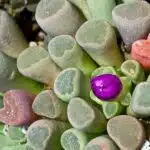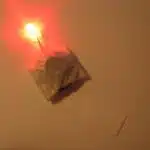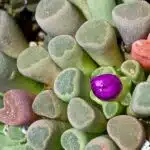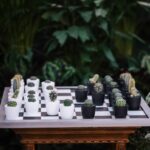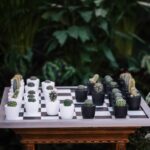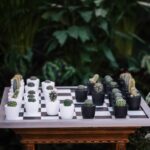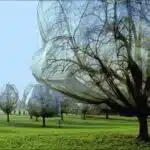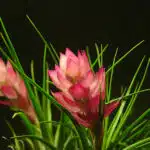Succulents are a popular choice for indoor and outdoor plant enthusiasts. These low-maintenance plants require minimal watering and can thrive in a variety of lighting conditions. However, determining the appropriate amount of light for your succulent is crucial to its survival and growth.
As a succulent care specialist, I have encountered numerous cases where improper lighting has led to stunted growth or even death of these beautiful plants. In this article, we will explore the various factors that affect the light requirements of succulents and provide practical tips on how to ensure your succulent receives the optimal amount of light it needs to flourish. Whether you are a seasoned succulent enthusiast or just starting out, understanding how much light your succulent needs is essential for its health and longevity.
The Importance Of Proper Lighting For Succulents
Lighting is to succulents what food is to humans, and just like humans need a balanced diet, succulents require proper lighting. The duration and intensity of light are crucial factors in determining the health and growth of succulents. Succulents are native to arid regions and have adapted to survive with limited water resources, but they thrive in bright sunlight. Proper lighting ensures that they receive enough energy for photosynthesis, which is essential for their survival.
Lighting duration plays a significant role in succulent growth. Succulents require at least six hours of direct sunlight each day to ensure proper growth and development. However, too much exposure to direct sunlight can damage their leaves by causing sunburn or drying them out. Therefore, it’s crucial to regulate the amount of time they spend under direct sunlight.
The intensity of light is equally important as the duration. Not all forms of light are suitable for succulent growth; therefore, it’s essential to provide them with the right amount of natural or artificial light. Too much bright light can burn their leaves, while too little can cause stunted growth or elongated stems. Finding the right balance is key to ensuring optimal succulent growth and health.
Proper lighting is critical for the overall health and development of succulents. In the next section, we will explore how photosynthesis plays a vital role in this process and how it affects their growth patterns over time.
The Role Of Photosynthesis In Succulent Growth
Proper lighting is crucial for the growth and development of succulent plants. As discussed in the previous section, a lack of adequate light can lead to stunted growth, stretched stems, and a loss of vibrant coloration. On the other hand, providing too much light can cause sunburn to the leaves or even death in extreme cases. This is why understanding the impact of light intensity on succulents is essential.
One way that proper lighting benefits succulents is through photosynthesis. Photosynthesis is a process where plants use light energy to convert carbon dioxide and water into glucose and oxygen. In other words, it’s how plants make their own food. Succulents rely heavily on photosynthesis as they grow in environments with limited nutrients and resources. A consistent supply of adequate light allows for efficient photosynthesis, which promotes healthy growth.
The impact of light intensity on succulent growth can vary depending on the species. Some succulents prefer bright, direct sunlight while others thrive in shaded areas with filtered light. It’s important to research the specific needs of your succulent before placing it in its permanent home. Additionally, factors such as temperature and humidity can affect how much light your plant requires. By understanding these variables, you can create an optimal environment for your succulent to flourish.
Moving forward, let’s explore different types of light and their effects on succulent plants.
Types Of Light And Their Effects On Succulents
- Natural light is the ideal light source for succulents, as it is the closest to the natural light they would receive in their native habitats.
- Artificial light can be used to supplement natural light or to provide additional light for succulents.
- Sunlight exposure is important for succulents, as it helps to provide the necessary energy for photosynthesis and helps to prevent the succulents from becoming leggy.
- Too much sunlight can damage succulents, as the intense heat can cause sunburn and scorch the leaves.
- Succulents should be placed in an area that receives bright, indirect light for best results.
- It is important to monitor the amount of light the succulents are receiving and adjust the intensity of the light accordingly.
Natural Light
Maximizing natural light is crucial for the optimal growth and health of succulents. Natural light provides a range of benefits that artificial sources cannot replicate, including full-spectrum lighting and an appropriate temperature range. However, it’s important to note that there are also drawbacks to relying solely on natural light. For example, direct sunlight can cause sunburn and leaf damage if not properly managed.
To maximize the benefits of natural light while minimizing its drawbacks, it’s important to provide succulents with indirect sunlight whenever possible. This can be achieved by placing them near windows or using sheer curtains to filter out some of the direct sun rays. It’s also important to rotate your plants regularly so that all sides receive equal amounts of sunlight. This will ensure that your succulents grow evenly and develop strong root systems.
In conclusion, maximizing natural light is essential for the health and longevity of your succulent collection. By understanding the benefits and drawbacks of natural light, you can take steps to create an optimal growing environment for your plants. Incorporating these tips into your succulent care routine will help you create a thriving garden full of healthy, happy plants.
Artificial Light
As a succulent care specialist, it’s important to understand the benefits and drawbacks of artificial light for your plants. While natural light is ideal, sometimes it’s not always possible to provide enough of it. Artificial light can supplement natural light and provide additional benefits, such as extended lighting hours and consistent lighting levels. However, there are also drawbacks to using artificial light, including the risk of overexposure and heat damage if the wrong type or intensity of light is used.
The best artificial light sources for succulent growth include LED grow lights and fluorescent lights. LED grow lights are energy-efficient and emit minimal heat, making them a safe option for indoor gardening. They also provide full-spectrum lighting that closely mimics natural sunlight, allowing your plants to thrive even in low-light conditions. Fluorescent lights are another great option for indoor gardening as they emit little heat and come in a range of sizes and colors.
While using artificial light can be beneficial for your succulents’ growth, it’s important to monitor their exposure to it carefully. Overexposure or using the wrong type of light can cause damage or stunted growth. As with natural light, rotating your plants regularly under artificial lighting sources will ensure that all sides receive equal amounts of light exposure. By incorporating these tips into your succulent care routine, you can create an optimal growing environment for your plants that maximizes the benefits of both natural and artificial lighting sources.
Sunlight Exposure
As a succulent care specialist, it’s important to understand the effects of sunlight exposure on your plants. While succulents require ample light to thrive, excessive sunlight exposure can be detrimental to their growth. It’s crucial to strike a balance between providing enough light and protecting your plants from harsh rays.
The importance of shade cannot be overstated when it comes to succulent care. Overexposure to direct sunlight can cause sunburn, discoloration, and even death for your plants. Providing adequate shade is crucial for preventing these issues. This can be achieved by placing your succulents in areas with partial or filtered sunlight or by using shading materials such as mesh screens or sheer curtains.
For those living in high altitude areas, it’s important to note that lighting conditions may differ from those at sea level due to changes in atmospheric conditions. Plants may require more intense lighting in high altitude areas due to the thinner atmosphere that filters out some of the sun’s rays. It’s recommended for succulent owners in such areas to make necessary adjustments based on their plant’s needs and monitor their exposure carefully.
By understanding the importance of shade and being aware of high altitude lighting conditions, you can provide optimal growing conditions for your succulents while protecting them from harmful sunlight exposure. Incorporating these tips into your succulent care routine will ensure that your plants receive the right amount and type of light they need for healthy growth.
Natural Vs. Artificial Lighting For Succulents
Choosing between natural and artificial lighting can be a daunting task for succulent enthusiasts. Natural light is ideal, but not always accessible. The amount of sunlight that a succulent needs varies from species to species and depends on the location of the plant. On the other hand, artificial lighting can provide consistent light throughout the day, regardless of weather conditions or seasonal changes.
If you are limited in space or live in an area with little natural sunlight, artificial lighting may be your best option. LED grow lights are one of the best succulent lighting options for small spaces. They emit low heat and provide specific wavelengths needed for plant growth. Fluorescent lights are another option that provides broad-spectrum light that mimics natural sunlight.
While both natural and artificial lighting have their benefits, it’s important to remember that too much or too little light can harm your succulent’s health. It’s crucial to monitor your plant’s response to its environment and adjust accordingly.
Factors That Affect Succulent Light Requirements
Now that we’ve covered the basics of natural vs. artificial lighting let’s dive into factors that affect succulent light requirements. Different species require different levels of sunlight, so it’s essential to research your plant’s specific needs before providing any type of lighting. Some factors that affect a succulent’s light requirements include its native habitat, leaf coloration, and age. By understanding these factors, you’ll be able to create an optimal environment for your succulent to thrive in!
Factors That Affect Succulent Light Requirements
Succulents are known for their ability to thrive in arid conditions, and proper lighting is crucial for their growth and development. Light intensity and duration are two important factors that affect the light requirements of succulents.
Intensity: Succulents require bright, indirect light to grow properly. Direct sunlight can scorch the leaves of many succulent species, causing them to turn brown or white. However, some species such as cacti can tolerate direct sunlight for several hours a day.
Duration: In addition to intensity, the duration of light exposure is also important. Succulents require at least six hours of sunlight per day to maintain healthy growth. If they receive less than six hours, they may become leggy and stretched out as they try to reach for more light.
Location: The location of your succulent also affects its lighting needs. Indoor succulents need brighter light compared to outdoor ones because natural light is usually filtered through windows which reduce the intensity of the light.
Seasonal changes: Finally, it’s important to consider seasonal changes when assessing your succulent’s lighting needs. During the summer months when days are longer, your plant may require more frequent watering due to increased evaporation caused by higher temperatures and stronger sunlight.
Proper lighting is essential for healthy succulent growth, but it’s important to remember that each plant has unique needs depending on its species and location. Assessing your succulent’s lighting needs involves understanding its individual requirements and making adjustments as necessary based on factors such as intensity, duration, location, and seasonal changes. Taking these factors into account will help ensure that your succulent thrives in its environment and remains healthy over time.
Assessing Your Succulent’s Lighting Needs
After exploring the various factors that affect succulent light requirements, it is important to assess your succulent’s specific needs. Assessing natural light is the first step in determining how much light your plant requires. Succulents thrive in bright but indirect sunlight, so it’s important to observe the amount of sunlight that your plant receives and make adjustments as necessary.
If natural light is insufficient for your succulent, there are artificial lighting options available. LED grow lights are a popular choice among succulent enthusiasts because they provide the full spectrum of light needed for optimal growth while consuming less energy than traditional lighting options. When using artificial lighting, it’s important to keep in mind that succulents still need periods of darkness to rest and rejuvenate.
Assessing your succulent’s lighting needs may seem daunting at first, but with careful observation and adjustment, you can create an optimal growing environment for your plant. However, it’s important to be mindful of signs of too much light for your succulent. These signs can include scorch marks on the leaves or a bleaching effect on the plant’s coloration. By regularly monitoring and adjusting your succulent’s lighting conditions, you can help ensure its health and longevity.
Signs Of Too Much Light For Succulents
Excessive light exposure can be detrimental to succulents and cause a range of adverse effects. Overexposure symptoms can include brown or white patches on the leaves, leaf drop, stunted growth, or sunburn. These symptoms may not appear immediately but can become noticeable after several days of overexposure. To avoid such issues, it is essential to pay attention to the amount of light that your succulent receives.
Optimal placement of succulents is crucial to prevent overexposure. Placing them near a window facing south or west where the sunlight is most intense may lead to overexposure. Instead, placing them in an east-facing window or a few feet away from a south/west-facing window can provide enough bright light without causing harm. In some cases, you may need to move your succulent around until you find the best spot for it.
If you notice signs of overexposure in your succulent, prompt action is necessary to save it from further damage. The first step would be to move it away from the source of intense light and into a shadier spot. If there are brown patches on the leaves, you can trim them off using sterile scissors or pruning shears. Be careful not to cut too much as this could cause further damage. With proper care and attention, your succulent should recover within a few weeks if not sooner.
As we have seen excessive light exposure can harm your succulent’s health and reduce its lifespan significantly. However, underexposure is just as harmful if not more so than overexposure for some species of succulents. In the next section, we will explore signs of not enough light for succulents and how you can remedy this issue effectively without causing harm to your plant’s health and well-being.
Signs Of Not Enough Light For Succulents
As the saying goes, “light is life” for succulents. In the previous section, we discussed signs of too much light for these plants. Now, let’s explore the implications of insufficient light and how to identify low light stress in succulents.
Insufficient light can hinder succulent growth and cause them to become etiolated or stretched out. This happens because the plant is reaching for more sunlight and stretching its stem in an attempt to get closer to it. Etiolated succulents may also have smaller leaves and weak root systems, making them more susceptible to disease and pests.
To identify low light stress in your succulent, look for visual cues such as elongation of stems, pale or yellowing leaves, and a lack of new growth. If you notice any of these signs, it’s time to adjust your lighting situation.
Here are some tips for adjusting lighting for indoor succulents:
- Place them near a south-facing window where they can receive bright but indirect sunlight.
- Consider using grow lights if natural light is not sufficient.
- Use LED grow lights that emit blue or red wavelengths.
- Adjust the height and distance between the plant and grow light according to the manufacturer’s instructions. By providing adequate lighting, you can ensure healthy growth and vibrant color in your beloved succulents.
Adjusting Lighting For Indoor Succulents
To ensure the health and growth of your indoor succulents, it is crucial to adjust their lighting conditions. These plants are adapted to thrive in bright, direct sunlight, but too much exposure can lead to sun damage. On the other hand, insufficient light can cause them to become etiolated and weak. As such, it is essential to find a balance that provides adequate brightness without overexposure.
Adjusting brightness is key when caring for your indoor succulents. If your plants are located near a window with direct sunlight, consider moving them back a few feet or adding sheer curtains to diffuse the rays. Alternatively, you can use natural light alternatives such as LED grow lights that mimic the sun’s intensity and spectrum. These lights come in different sizes and designs, making them suitable for various spaces.
When adjusting lighting for indoor succulents, it is important to note that each species has unique requirements. Some varieties like Haworthia and Gasteria prefer low light conditions, while others like Aloe Vera and Echeveria require ample sunlight. Thus, research on individual species needs can help you determine how best to optimize their care regime.
Transition: Now that you have adjusted the lighting for your indoor succulent, let’s move on to choosing the right outdoor location for your plant’s optimal growth and development.
Choosing The Right Outdoor Location For Your Succulent
Did you know that outdoor placement plays a crucial role in the growth and survival of your succulent? While some succulents can thrive indoors with minimal sunlight, most species require ample light exposure to flourish. Therefore, choosing the right outdoor location for your succulent is essential for its well-being.
Here are some factors to consider when selecting an outdoor spot for your succulent:
- Sun Exposure: Succulents need at least six hours of direct sunlight daily. However, they cannot tolerate intense midday sun, which can scorch their leaves.
- Temperature: Most succulents prefer warm temperatures ranging between 60°F and 80°F. They can survive colder temperatures but will not grow as quickly.
- Drainage: Succulents require well-draining soil and pots to prevent waterlogging. Therefore, it’s crucial to choose an outdoor spot with good drainage to avoid root rot.
- Airflow: Good air circulation prevents pests and diseases from attacking your succulent. Avoid planting them in areas with stagnant air or overcrowding.
- Soil Type: Most succulents thrive in sandy soil with a slightly acidic pH level. It’s important to test the soil’s pH level before planting.
Now that you’ve chosen the ideal outdoor location for your succulent let’s discuss how you can protect it from harsh sunlight.
Protecting Your Succulent From Harsh Sunlight
Sunburn prevention is crucial in taking care of your succulent. Succulents require a certain amount of light to thrive, but too much direct sunlight can damage their leaves and cause sunburn. Sunburn is characterized by brown or white spots on the leaves, which can eventually lead to the death of the plant. Therefore, it is important to protect your succulent from harsh sunlight.
Shading techniques are effective in preventing sunburn on your succulent. You can use various shading materials such as shade cloth, sheer curtains, or even a piece of cardboard to filter the strong rays of the sun. Place the shading material over your succulent during the hottest part of the day when the sun’s rays are at their strongest. This will help prevent sunburn and keep your succulent healthy.
In addition to shading techniques, you can also move your succulent to a location where it receives indirect sunlight. Indirect sunlight provides enough light for your succulent without exposing it to direct sunlight. If you notice signs of sunburn on your succulent’s leaves, move it away from direct sunlight immediately and place it in an area with indirect sunlight. This will allow your succulent to recover and prevent further damage.
To supplement light for indoor succulents, artificial lighting can be used. Properly placed grow lights provide sufficient light for indoor plants and ensure that they receive adequate light regardless of their location in the house. It is important to choose a high-quality grow light that emits a spectrum similar to natural light and adjust its height according to the needs of each individual plant species. With proper lighting and shading techniques, you can keep your succulents healthy and thriving all year round.
Supplementing Light For Indoor Succulents
- When supplementing light for indoor succulents, it is important to consider the type of artificial light being used, as certain lights may provide more beneficial spectrum than others.
- Additionally, positioning succulents for optimal lighting is key, as the amount of light and duration of exposure can have significant impacts on plant health and growth.
- Artificial lighting options for succulents commonly include fluorescent lighting, LED lighting, and incandescent lighting, which can be used to supplement natural light from windows.
- It is essential to consider the intensity of light, distance from the source, and duration of exposure when deciding on the best lighting for succulents.
Types Of Artificial Light For Succulents
The amount of light that succulents require varies depending on the species. Generally, succulents need at least six hours of sunlight each day. However, indoor succulents may not receive sufficient light from natural sources, particularly during the winter months when daylight hours are shorter. Supplementing light for indoor succulents is essential to keep them healthy and thriving. There are two types of artificial light options available for indoor succulent growers: LED and fluorescent lights.
LED lights are a popular choice among indoor gardeners due to their energy efficiency and long lifespan. They produce little heat while emitting a high-intensity light that mimics daylight, making them ideal for growing succulents indoors. Fluorescent lights, on the other hand, are less expensive than LED lights but have a shorter lifespan. They also emit more heat than LED lights and require more wattage to produce the same intensity of light. When choosing between LED and fluorescent lights for your succulent garden, consider your budget, space availability, and the specific needs of your plants.
When it comes to wattage and intensity levels for artificial lighting in succulent gardens, it’s crucial to find a balance that meets the needs of your plants without damaging them. Most succulent species thrive under low to moderate lighting conditions with an intensity range between 1500 and 3000 lumens per square foot. Wattage requirements vary depending on the size and number of plants you’re growing in your indoor garden. As a general guideline, aim for 20-30 watts per square foot for LED lights or 40-60 watts per square foot for fluorescent lights.
In conclusion, supplementing light is necessary for maintaining healthy indoor succulents. Choosing between LED and fluorescent lighting depends on personal preference and budget constraints; however, both can provide sufficient levels of wattage and intensity required by most species of succulents. It’s crucial to find a balance between wattage and intensity levels to ensure that your plants thrive without being damaged by excessive light.
Positioning Succulents For Optimal Lighting
As a succulent care specialist, it’s essential to consider the placement of your indoor plants when supplementing light. Even with the best grow light options available, improper plant placement can hinder their growth and health. When positioning succulents for optimal lighting, consider the direction of natural light sources and the intensity of artificial lighting.
Plants placed too far from a light source may not receive enough energy to photosynthesize effectively. On the other hand, plants placed too close to a light source risk getting scorched or damaged by excessive heat. Generally, succulents should be positioned within 12-18 inches of a grow light source for optimal results.
Another factor to consider is the direction of natural light sources in your home or office. Succulents should be placed near windows that face south or west as they receive more direct sunlight throughout the day. However, be mindful of any obstructions that may block natural sunlight from reaching your plants.
By considering both plant placement and grow light options, you can create an ideal environment for your indoor succulents to thrive. Remember to regularly monitor their growth and adjust lighting as necessary to ensure they receive the appropriate level of illumination without being damaged by excessive amounts of light.
Common Mistakes To Avoid When It Comes To Succulent Lighting
As the saying goes, “a little goes a long way.” This is especially true when it comes to succulent lighting. One of the most common mistakes people make is providing too much light or not enough. Finding the optimal exposure for your succulent can be tricky, but it’s crucial for its growth and overall health.
One mistake people make is assuming that all succulents require the same amount of light. However, different species have different preferences when it comes to light intensity and duration. Some may thrive in direct sunlight, while others prefer indirect or filtered light. It’s essential to research your specific type of succulent and adjust accordingly.
Another common mistake is placing your succulent too far or too close to a light source. Placing it too far may result in inadequate lighting, while placing it too close may lead to scorching or burning of the plant’s leaves. It’s best to experiment with different distances until you find the ideal placement for your succulent.
- Use a light meter to measure the intensity of your succulent’s current lighting environment.
- Consider using artificial grow lights if natural light isn’t sufficient.
- Rotate your succulent every few weeks to ensure even exposure on all sides.
To ensure that your succulent stays healthy, it’s essential to avoid these common mistakes when it comes to lighting. However, sometimes even with optimal exposure, issues can arise with your plant’s lighting needs. In our next section, we’ll discuss troubleshooting light-related problems that may occur with your succulent.
Troubleshooting Light-Related Issues With Your Succulent
- Succulents require specific light conditions for optimal health, so it is important to identify the light requirements for the succulent species in question.
- Adequate light exposure should be provided to the succulent, but it is also important to avoid overexposure.
- Proper light management is essential for successful succulent care, as too little or too much light can cause issues with growth and appearance.
- Careful consideration should be taken when choosing the location of the succulent, as the environment must provide access to suitable light levels and should be monitored to ensure the succulent is not stressed by overexposure.
Identifying Light Requirements
Do you want to know how much light your succulent needs? Identifying light requirements is crucial in troubleshooting light-related issues with your plant. As a succulent care specialist, I recommend assessing the shade and understanding orientation to determine the right amount of light for your succulent.
Assessing shade is essential in identifying the light requirements of your succulent. If your plant receives too much or too little sunlight, it can lead to various issues. Succulents that receive insufficient light may become leggy and weak, while those exposed to too much direct sunlight may develop sunburn or scorch marks. To avoid these problems, place your plants in a spot where they can receive enough filtered sunlight or partial shade.
Understanding orientation also plays a vital role in determining the amount of light your succulent needs. Proper orientation depends on the natural environment where your plant thrives. For instance, some species require more exposure to direct sunlight than others do. So if you’re growing succulents indoors, make sure you rotate them occasionally or move them to different areas where they can receive adequate lighting from all angles.
In conclusion, identifying light requirements is crucial in troubleshooting any light-related issues with your precious succulents. Thus, it’s essential to assess shade and understand orientation carefully to provide optimal lighting conditions for their growth and well-being. Keep these tips in mind, and you’ll have healthy and happy succulents that will thrive for years to come!
Managing Succulent Light Exposure
Assessing shade and understanding orientation are essential in identifying the light requirements of your succulent. However, managing exposure to light is just as crucial in ensuring its optimal growth and development. One way to manage light exposure is by considering the light spectrum that your plant receives.
Different types of succulents have varying needs when it comes to the spectrum of light that they require. Some species thrive under full-spectrum lighting, while others only need specific wavelengths such as red and blue lights for photosynthesis. It’s crucial to understand which type of lighting is best suited for your plant’s growth and adjust accordingly.
Another important factor to consider when managing exposure to light is its duration. While succulents need adequate sunlight or artificial lighting, overexposure can be detrimental to their health. Ensure that your plants receive enough time under direct sunlight or artificial lighting, but also make sure they get enough rest periods in between these exposures.
In summary, managing exposure to light is a critical aspect of caring for your succulent’s well-being. Understanding the light spectrum and duration helps ensure that your plant gets the right kind and amount of light it needs for optimal growth and development. By keeping these factors in mind, you can troubleshoot any potential issues related to lighting, leading to healthier and happier succulent plants.
Conclusion: Achieving Optimal Lighting For Your Succulent
When it comes to lighting options for your succulent, there are a few factors to consider. Firstly, it’s important to understand that succulents require bright light in order to thrive. However, this does not mean they should be exposed to direct sunlight all day long. In fact, too much intense light can damage the leaves and even cause sunburn.
To achieve optimal lighting conditions for your succulent, it is best to provide them with indirect or filtered sunlight. This can be achieved by placing them near a window with sheer curtains or by using a grow light specifically designed for plants. When using artificial lighting options, it’s important to ensure that the light intensity is not too strong as this may also damage your plant.
In summary, providing your succulent with adequate lighting is crucial for their overall health and growth. By understanding the different lighting options available and the appropriate light intensity required for your plant, you can create an ideal environment that will help your succulent thrive. Remember to monitor your plant regularly for any signs of stress or damage and adjust their lighting conditions accordingly.
Conclusion
Proper lighting is crucial for the growth and health of succulents. Succulents, like all plants, require sunlight to carry out photosynthesis, the process by which they convert light energy into chemical energy to fuel their growth and development. However, not all light is created equal, and different types of light have varying effects on succulent growth.
Natural light is the best source of light for succulents. However, if you are growing your succulent indoors or in an area with low natural light levels, artificial lighting can be used to supplement their light requirements. When it comes to artificial lighting for succulents, there are various options available such as fluorescent lights, LED grow lights, and High-Intensity Discharge (HID) lights.
Factors such as the intensity and duration of light exposure can impact a succulent’s growth. Overexposure to direct sunlight or prolonged exposure to artificial lighting can lead to sunburn or dehydration in your plant. On the other hand, insufficient lighting can cause stunted growth or a lack of flowering.
In conclusion, achieving optimal lighting conditions for your succulent requires careful consideration of various factors such as natural vs. artificial lighting sources, duration and intensity of exposure, and environmental factors like temperature and humidity levels. As a succulent care specialist, my advice would be to observe your plant closely and adjust its lighting conditions accordingly. With patience and attention to detail, you can ensure that your succulent thrives under the right amount of light.
Image Credits
- “Very Strange Succulent” by Steve Corey (featured)



